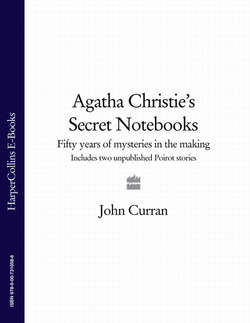Читать книгу Agatha Christie’s Secret Notebooks: Fifty Years of Mysteries in the Making - Includes Two Unpublished Poirot Stories - John Curran - Страница 29
The Detection Club in the Notebooks
ОглавлениеThe main reference to the Detection Club in the Notebooks is in Notebook 41, the first page of which is headed ‘Ideas 1931’ (despite the uncertainty about its date of foundation, by the time of this note the club was well established):
The 13 at Dinner
Detective story Club (?)
Miss Sayers and her husband—Poisons
Mr Van Dine and
Mr Wills Crofts and wife—Alibis
Mrs Christie
Mr Rhode
Mr and Mrs Cole
Mr Bentley
Miss Clemence Dane
Mr Berkeley and wife—fantastic writer
Coincidentally, the title Thirteen at Dinner was used in America two years later for Christie’s 1933 novel Lord Edgware Dies. The US title refers to Chapter 15 of the book, where a character remarks that there were 13 guests at the dinner table on the evening of Lord Edgware’s death, thereby giving Lady Edgware 12 witnesses. It is unlikely, however, that this is what Christie had in mind when she sketched the Detection Club idea.
Of the 13 people she lists who would have composed this party, most of them were her fellow-writers. ‘Miss Sayers’ is Dorothy L. Sayers—writer, dramatist, anthologist, theologian and scholar—Christie’s great contemporary and one of the founders of the Detection Club. Although listed in Notebook 41 as ‘Miss’, Sayers had married Oswald Fleming in April 1926 but retained her maiden name for her professional activities.
‘Mr Van Dine’ was known to the reading public as S.S. Van Dine, creator of Philo Vance. The gap after his name would seem to indicate that Christie was not sure if he was married (he was), but the inclusion of his partner would have given 14 dinner guests—which perhaps accounts for the uncertainty. It is odd that Christie should have included Van Dine at all. She certainly read his novels—a few are on the shelves in Greenway House—as they were enormous bestsellers in their day, but he was not a member of the Detection Club as he lived in America.
‘Mr Wills Crofts’ was Freeman Wills Crofts, creator of Inspector French of Scotland Yard, a painstaking and thorough policeman whose speciality (as indicated) is the unbreakable alibi. Like Christie his first novel, The Cask, appeared in 1920 and is still considered a classic. He continued to write until his death in 1955, producing over 40 novels.
‘Mr Rhode’ is John Rhode, whose real name was Major Cecil John Charles Street and who also wrote as Miles Burton. Like Christie he was a Crime Club author for most of his career and altogether he wrote almost 150 novels under both names.
‘Mr and Mrs Cole’ was the husband-and-wife team of G.D.H. and Margaret Cole, detective novelists and Socialists. Although the pair were prolific, with 30 novels to their credit, their books are verbose, lifeless and long out of print.
‘Mr Bentley’ was E.C. Bentley, whose reputation as a detective novelist rests almost entirely on one novel, the classic Trent’s Last Case. He also issued a book of short stories and co-wrote another title, Trent’s Own Case, both featuring Philip Trent.
Clemence Dane is largely forgotten as a crime writer. Enter Sir John, filmed by Hitchcock as Murder, is her best-known title.
‘Mr Berkeley’ is Anthony Berkeley, who also wrote as Francis Iles. A very influential writer, he foresaw the emergence of the crime novel, as distinct from the detective novel, and his contribution to both branches of the genre is impressive. Alfred Hitchcock memorably filmed his Iles novel Before the Fact as Suspicion.
In addition to this list, Christie makes various allusions to her fellow Detection Club members in a range of works. Partners in Crime, Christie’s 1929 Tommy and Tuppence collection of short stories, sees the Beresfords investigating their cases in the style of various detectives. She pastiches Berkeley in ‘The Clergyman’s Daughter’ and Crofts in ‘The Unbreakable Alibi’ although, oddly, none of the other writers mentioned in Notebook 41 is featured.
An article Christie wrote for the Ministry of Information in 1945, ‘Detective Writers in England’, is also of note. Here the writers featured are Dorothy L. Sayers, John Dickson Carr, H.C. Bailey, Ngaio Marsh, Austin Freeman and Margery Allingham—Sayers being the only writer common to the article and Notebook 41, although all were members of The Detection Club. This may be due to the fact that Christie had more dealings with Sayers, mostly during the planning of the collaborative titles The Floating Admiral, The Scoop and Behind the Screen, all of which were masterminded by Sayers.
Chapter 6 of The Body in the Library also mentions Sayers, H.C. Bailey and John Dickson Carr (as well as Christie herself); and ‘The Flock of Geryon’, the tenth Labour of Hercules, mentions Sherlock Holmes, Mr Fortune, the creation of Bailey, and Sir Henry Merrivale, the creation of Dickson Carr. Dickson Carr’s The Burning Court is also a minor clue in Evil under the Sun and the same writer gets a further mention in The Clocks.
A single sentence each in Notebooks 18 and 35 also mentions the Detection Club, both with the same idea:
Guest night at the Det[ection] Club during ritual—Mrs. O[liver]’s 6 guests
Detection Club Murder—Mrs Oliver—her two guests—someone killed when the Ritual starts
Guest Night was, not surprisingly, an evening when members of the club could invite a guest for dinner. The ‘ritual’ was the ceremony, involving the swearing of an ‘oath’ with Eric the Skull standing in for the Bible, at which new members were initiated. As a detective novelist Mrs Oliver would, of course, have been a member of the club.
